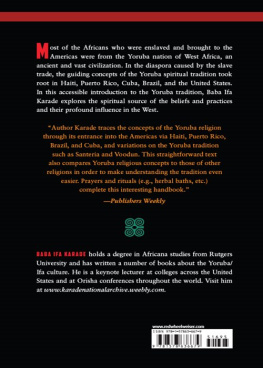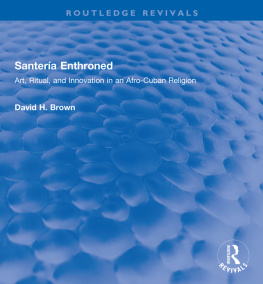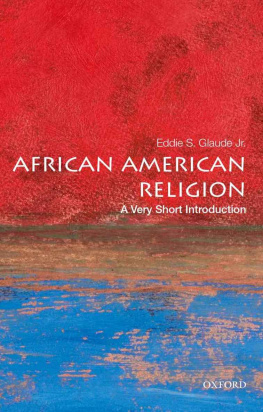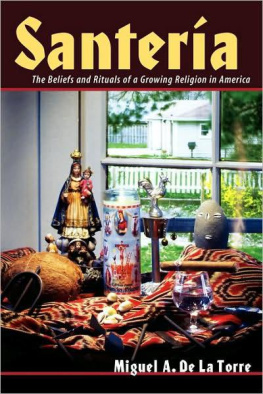STUDIES IN
AFRICAN AMERICAN HISTORY AND CULTURE
edited by
GRAHAM RUSSELL HODGES
COLGATE UNIVERSITY
MAKING THE GODS IN NEW YORK
THE YORUBA RELIGION IN THE AFRICAN AMERICAN COMMUNITY
MARY CUTHRELL CURRY
First published 1997 by Garland Publishing Inc.
Published 2019 by Routledge
2 Park Square, Milton Park, Abingdon, Oxon OX14 4RN
52 Vanderbilt Avenue, New York, NY 10017
Routledge is an imprint of the Taylor & Francis Group, an informa business
Copyright 1997 by Mary Cuthrell Curry
All rights reserved. No part of this book may be reprinted or reproduced or utilised in any form or by any electronic, mechanical, or other means, now known or hereafter invented, including photocopying and recording, or in any information storage or retrieval system, without permission in writing from the publishers.
Notice:
Product or corporate names may be trademarks or registered trademarks, and are used only for identification and explanation without intent to infringe.
Library of Congress Cataloging-in-Publication Data
Curry, Mary Cuthrell.
Making the gods in New York : the Yoruba religion in the African American community / Mary Cuthrell Curry.
p. cm. (Studies in African American history and culture)
Includes bibliographical references and index.
ISBN 0-8153-2919-9 (alk. paper)
1. SanteriaNew York (State)New YorkHistory20th century. 2. New York (N.Y.)Religion20th century. I. Title. II. Series.
BL2532.S3.C88 1997
299.674097471dc21
97-8411
ISBN 13: 978-0-8153-2919-0 (hbk)
Dedication
This book is dedicated to my husband David and my son Anjorin. David encouraged me to get my PhD and not only cheerfully put up with the chaos that studying, oral examinations, writing and preparing for the dissertation defense involved but also critically read and discussed all that I wrote and at his insistence rewrote.
Most of Anjorins life was lived in the shadow of my effort to get the doctorate. He went to the University (on my back) long before he ever went to first grade. Most importantly, he connected me to the world and served as my chief of public relations.
Contents
A case study is a snapshot of a group at a particular point in time. My active investigation of Peters and Katherines House was ceased in 1990 in order for me to analyze and write up my findings. Since then, although I have not actively researched it, I have kept in close contact with the main core of the membership. The House, of course, has continued to grow since then and has become almost twice as large as it was since the time I ceased my active investigations. At the time of my first writing, there were forty-five initiated priests;, in 1997 there are eighty three with a possibility of at least four more initiations this year.
Having grown larger, it has also grown more complex. At the time of my writing it was two generations removed from its original Cuban founder but now a third and fourth generation has been added and soon, it will probably have a fifth.
In addition to increasing in number and complexity, it has begun to spread more geographically, in the United States and even internationally. In the future, it is reasonable to expect sub-houses to develop in those places where priests have settled. How this will impact the structure of Peters and Katherines House will be an interesting study.
Membership in the Religion is extremely diverse and continues to diversify; at the time of my first writing, there were Cuban Houses, Puerto Rican Houses, Black Houses and Multi-ethnic Houses. Now, depending upon the part of the country one considers, there are Polish Houses, Mexican Houses and Houses of other ethnic groups. However, most scholarly attention is given to Cuban Houses or considers the Religion without regard to ethnicity. Moreover, these studies (with certain exceptions, Gregory 1986, Brown 1989 and Vega 1995) tend to be broad in focus, considering the Religion as a whole or the United States in its entirety. Stephen Gregory, who studied a multi-ethnic House in the Bronx and Marta Vega, who produced a philosophical history both focused on New York City. While Brown limited his analysis to a particular house in New Jersey, Making The Gods in New York, to the best of my knowledge is the only case study of an African American House. With the exception of Browns study, I do not know of any study of any other ethnic House.
I hope others will take up such investigations since the theoretical focus of my study is the practical religion of the converted, it would seem that other groups would have their own particular concerns which would shape their perception of the Religion. Various snapshots over a period of time will hopefully grant us an understanding of the ways in which religions spread and how receiving groups transform them for the own immediate concerns.
In many ways, this book has been a collaborative effort. The faculty at the Graduate Center of The City University of New York have proved especially helpful to me in modeling and providing constructive criticism of my work. I am especially grateful to George Fischer who taught me the art of close reading in his multi-semester seminar on The Sociology of Religion and who always acted as an invaluable nudge. Hylan Lewis gave me the advantage of his vast experience of research and always shared valuable insights on what I was observing. Lindsay Churchills one-on-one course in hands-on qualitative methodology was one of the most valuable experiences that I had at the Graduate Center. And not the least of all is Bogdan Denitch who always pressured me to finish.
I also want to thank the members of the Yoruba community who shared their time, information and insights with me, Although they are two many to name individually.
Decisions about spelling can be troublesome. Yoruba words are written according to three main spelling conventions: Yoruba, Spanish and English. Yoruba is a tone language which is conventionally considered to have three tones which are indicated as follows 1) the acute accent () marks high tones; 2) the grave accent () marks the low tone and 3) no accent marks the mid tone. The tops of letters are devoted to the tune of the word while the bottom of the letters are consigned to diacritical marks which mark differences in pronunciation. , for example, would be pronounced sh in English, while the pronunciation of s would be the same in English as in Yoruba. r would be the proper Yoruba spelling of Orisha and ng,

un,

,

batala, and

sanyn would be written Shango, Oshun, Elegba, Obatala and Osanyin respectively.
A further complication is that much of the literature transcribes Yoruba words phonetically according to Spanish orthographic rules. To cite two examples, since there is no sh in Spanish, the Yoruba sh becomes ch as the closest Spanish equivalent and the Yoruba gb becomes gua hence Chango, Ochun, Elegua.








 un,
un,  ,
,  batala, and
batala, and  sanyn would be written Shango, Oshun, Elegba, Obatala and Osanyin respectively.
sanyn would be written Shango, Oshun, Elegba, Obatala and Osanyin respectively.